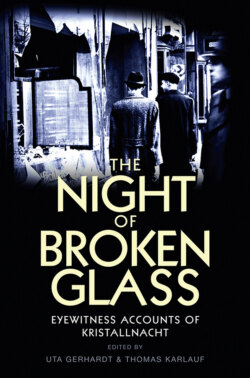Читать книгу The Night of Broken Glass - Группа авторов - Страница 10
Notes
Оглавление1 1. From Harry Kaufman’s account, cf. pp. 231–5.
2 2. Quoted from Saul Friedländer, Nazi Germany and the Jews, vol. 1, The Years of Persecution 1933–1939, New York, 1997, p. 268. Cf. Trude Maurer, ‘Abschiebung und Attentat. Die Ausweisung der polnischen Juden und der Vorwand für die Kristallnacht.’ In Walter H. Pehle, ed., Der Judenpogrom 1938. Von der ‘Reichskristallnacht’ zum Völkermord. Frankfurt am Main, 1988, pp. 52–73.
3 3. In the hearings preparatory to his show trial in 1942, Grynszpan referred to these rumours and implied that he had had a homosexual relationship with vom Rath; this spared him being judged by the People’s Court. But he was killed anyway – probably in the same year, in Sachsenhausen concentration camp. On the details of Grynszpan’s fate and the preparations for the trial, see Hans-Joachim Döscher, ‘Reichskristallnacht’. Die Novemberpogrome 1938. Munich, 2000, pp. 159–84.
4 4. Facsimile in Döscher, op. cit., p. 79.
5 5. Max Domarus, ed., Hitler. Reden und Proklamationen 1932–1945. Leonberg, 1988, vol. 2, p. 574 f.
6 6. Instructions to the press quoted from Peter Longerich, ‘Davon haben wir nichts gewusst!’ Die Deutschen und die Judenverfolgung 1933–1945. Berlin, 2006, p. 124.
7 7. Ruth Andreas-Friedrich, Der Schattenmann. Tagebuchaufzeichnungen 1938–1945. Berlin, 1947, p. 28 f.
8 8. For the most detailed account, see Angela Hermann, ‘Hitler und sein Stosstrupp in der “Reichskristallnacht”.’ In Viertelsjahrshefte für Zeitgeschichte 56(4) (October 2008), pp. 603–19; here, p. 606 f.
9 9. Hitler neither referred to the attack in his speech on the evening of 8 November in the Bürgerbräukeller nor spoke about it during the state funeral for Ernst vom Rath on 17 November in Düsseldorf. See ‘Die Fiktion eines spontanen Ausbruchs des Volkszorns gebot Schweigen’; Friedländer, op. cit., p. 300.
10 10. Ian Kershaw, Hitler. London, 2008, p. 461.
11 11. Die Tagebücher von Joseph Goebbels. Im Auftrag des Instituts für Zeitgeschichte und mit Unterstützung des Staatlichen Archivdienstes Rußlands, ed. Elke Fröhlich. Munich, 1993 ff., part 1, vol. 6, p. 178, entry for 9 November 1938.
12 12. Zum Judenproblem. Januar 1937. Quoted from Die jüdische Emigration aus Deutschland. 1933–1941. Die Geschichte einer Austreibung. Eine Ausstellung der Deutschen Bibliothek Frankfurt am Main, unter Mitwirkung des Leo Baeck Instituts. New York and Frankfurt am Main, 1985, p. 216.
13 13. Goebbels, Tagebücher, part I, vol. 6, p. 180, entry for 10 November 1938.
14 14. Quoted from Döscher, op. cit., p. 133.
15 15. Quoted from Die jüdische Emigration aus Deutschland, op. cit., p. 71.
16 16. Ibid., p. 68.
17 17. Ibid., p. 69 f.
18 18. Goebbels, Tagebücher, part I, vol. 4, p. 429, entry for 30 November 1937.
19 19. Quoted from Die jüdische Emigration aus Deutschland, op. cit., p. 71 f.
20 20. Goebbels, Tagebücher, part I, vol. 6, p. 180, entry for 10 November 1938.
21 21. According to the Supreme Court of the Nazi Party, in a decision issued on 13 February regarding the question of how Goebbels’s speech and the carrying out of the orders were to be understood. It was necessary to call upon the party’s court in order to fabricate a state of emergency and thus spare the perpetrators a criminal proceeding. Quoted from Der Prozess gegen die Hauptkriegsverbrecher vor dem Internationalen Militärgerichtshof (IMT), Nürnberg 1948, vol. 32, pp. 20–9.
22 22. Ibid.
23 23. Quoted from Friedländer, op. cit., p. 292.
24 24. Kershaw, op. cit., p. 458. ‘Disorder and uncontrolled violence and destruction were not the SS’s style.’
25 25. Facsimile in Döscher, op. cit., pp. 95–7.
26 26. Dachau: 10,911 deliveries; Buchenwald: 9,845 deliveries; Sachsenhausen an estimated 6,000–10,000 deliveries.
27 27. Goebbels, Tagebücher, part I, vol. 6, p. 182, entry for 11 November 1938.
28 28. Ibid.
29 29. Instructions to the press quoted in Longerich, op. cit., p. 125.
30 30. Quoted from Avraham Barkai, ‘ “Schicksalsjahr 1938”. Kontinuität und Verschärfung der wirtschaftlichen Ausplünderung der deutschen Juden.’ In Pehle, op. cit., p. 99.
31 31. It is all the more astounding that the stenographic record has still not been published in toto. The literature cites the partial record presented to the International Military Court in Nuremberg: IMT, op. cit., vol. 28, p. 499 ff. Cf. Döscher, op. cit., p. 123 f., there pp. 133–44.
32 32. Domarus, op. cit., vol. 3, p. 1058.
33 33. Harry Kaufman, unpublished manuscript (Houghton Library, Harvard University, bMS Ger 91, File 108); extracts from memoirs in this volume, pp. 231–5.
34 34. Both concepts were formed in connection with Auschwitz, but can be directly applied to the November pogroms. A good overview of the state of the question in Longerich, op. cit., pp. 7–21.
35 35. Longerich, op. cit., p. 24.
36 36. Ibid., p. 133.
37 37. November Pogrom 1938. Die Augenzeugenberichte der Wiener Library, London. Ed. Von Ben Barkow, Raphael Gross and Michael Lenarz. Frankfurt am Main, 2008.
38 38. Moritz Berger, unpublished manuscript (Houghton Library, Harvard University, bMS Ger 91, File 24).
39 39. On the approach of the organizers, the scholarly preparations, and the evaluation of the materials, see the Afterword, p. 236 ff.
40 40. Cf. the Bibliography, p. 275 ff.
41 41. Cf. the Editor’s Note, p. vii ff.
